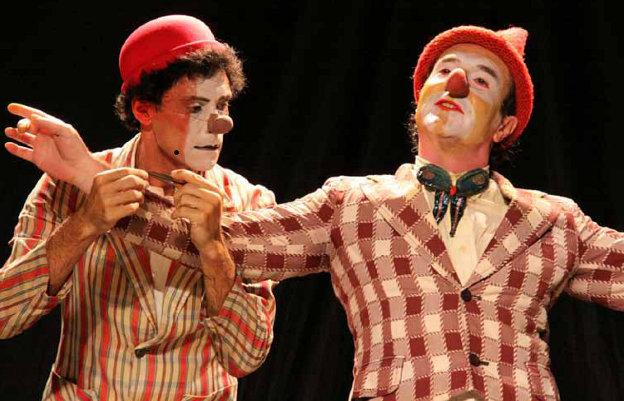Blackout, and we hear the William Tell overture. A grand entrance is anticipated; the same kind of anticipation I built when I was purchasing the Play Goes Wrong show tickets. Lights on – and, and… And here is Teotonio, who is delighted to be on stage. So delighted. It shows in every muscle of his body, which is as tightly primed as an overwound clockwork toy. He veers from nervous grinning at the audience to a worried exploration of the extremely large and forbidding empty space that is the SESC theatre stage. Nothing! Is he, Teotonio, supposed to do something? He doesn’t seem to know. Now what? There’s no hiding place, although he makes a feeble attempt to erase himself by retreating upstage, spread-eagling himself up against the blacks, his arms outstretched, his back to the audience. But there is no peace to be had, as he (and we) suddenly notice a tiny white spot on the black curtain, which has to be removed and disposed of – easier said than done.
The William Tell overture – encore. And this time we really do have a grand entrance, the arrival of the high-and-mighty Carolino, who takes immediate control of the situation with nose-in-air disdain and a regal wave of the hand, suitcases large and small organised into their X-marks-the-spot stage positions (Teotonio doing the actual donkey work, of course). All is prepared, on with the show!
What follows is a delicious clown parody of the instant-show-in-a-suitcase tradition. First up in the tricks and turns department is a demonstration of the marvellous skills of a tiny wooden trapeze artist (one of those simple mechanical children’s toys), pulled from a suitcase with great aplomb. In one of the many gorgeously realised moments in the show, the toy breaks, mini trapezist hurtling through the air to land in a broken heap, then anxiously given emergency resuscitation treatment by Teotonio, who weeps desperately – until he sees Carolino playing with a new toy, a push-along cycling puppet on a stick. The tiny trapezist is thrown to the dogs, and the new toy takes the spotlight…
More foolishness unfolds with the toys and the suitcases, and then there’s a shift in dynamic as Carolino disappears and his female alter-ego Gilda arrives onstage – a vision of blonde curls, dressed in a delightful blue-and-yellow polyester dress. She gyrates to the sound of the Gypsy Kings, lips slightly parted, hips circling, feet (clad in rather fetching blue towelling mules) swivelling on the spot. Teotonio is mesmerised. His attempts at courtship fail (Gilda is as high-and-mighty as Carolino, in her own inimitable way), but pride comes before a fall, and it’s not long before Gilda gets her comeuppance, which ends in her crashing arse-over-elbow to the floor, legs akimbo, with yellow lacy knickers revealing a rather unladylike bulge. Not to be outdone in the drag department, Teotonio dons a tutu and punk-pink hair ribbons – and ultimately the two ‘ladies’ together discover an Arcadian paradise in a suitcase full of flowers.
Cravo, Lirio e Rosa, created and performed by Carlos Simioni (Carolino) and Ricardo Puccetti (Teotonio) of LUME Teatro, first saw the light of day in 1996. It has subsequently become a mainstay of the company’s repertoire, appearing in festivals across Brazil – a continent-sized country – and throughout the world. It is classic theatre clown with a contemporary bite, playing with the traditional clown hierarchies of status with more than a touch of irony. We can see evidence of Ricardo Puccetti’s training with Philippe Gaulier; and evidence in both performers of the intense personal physical training, inspired by the legacy of Etienne Decroux disciple Luis Otávio Burnier, that is at the heart of LUME’s work.
So tradition is there in the foundations, but the show is very much its own unique self, built around the relationship of the two clown characters – and of course the relationship between the two actors, who have honed these wonderful clown characters in partnership over many years. The experience shows in the tremendous ease and control with which the game is played out: the timing is immaculate, and it is commendable that the two performers have allowed themselves the liberty of a slow and carefully orchestrated build. I particularly like the fact that music is used sparingly but effectively.
As with any good show, it’s the details that make the difference: that small white dot on the black curtains obsessively picked at, Gilda’s blue slippers shuffling rhythmically, the ludicrously manic way in which the push-along puppet is steered around the space, the arch of Carolino’s eyebrows and arrogant angle of his red nose, the jittery shake of Teotonio’s hands and his colt-like charges around the stage, the touching tenderness with which they finally make their peace…
Cravo Lirio e Rosa unsurprisingly garners a standing ovation on this, its opening night of a three-night run at the SESC Santana theatre. A lyrical piece of theatre, a great demonstration of clowning skills, and a lovely vehicle for the tremendous talents of LUME’s two longest-standing members. Bravo!


